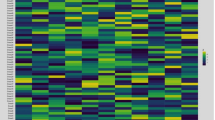Abstract
Analysis of genetic main effects and GE interaction effects for protein content (PC) and protein index (PI) of indica rice (Oryza sativa L.) was conducted for two year experimental data by using a genetic model for quantitative traits of seeds in cereal crops. Nine cytoplasmic male sterile lines or maintainers as female parents and five restorer lines as male parents were used for a NC II mating design in 1995 and 1996. The results indicated that PC and PI traits were simultaneously controlled by genetic main effects as well as GE interaction effects. For PC and PI of rice, the embryo interaction effects (embryo additive and dominance interaction effects) were important as effects of triploid endosperm, cytoplasm and diploid maternal plant. The estimates of narrow-sense heritability for PC and PI of rice were 85.3% and 77.9%, respectively. The interaction heritability was found to be larger than the general heritability for PC and PI of rice. Significant relationships for components of different genetic effects between PC and PI were found. The GE interaction covariances tended to be positive.
Similar content being viewed by others
References
Foolad, M.R. & R.A. Jones, 1992. Models to estimate maternally controlled genetic variation in quantitative seed characters. Theor Appl Genet 83: 360–366.
Gupta, M.P., P.K. Gupta, I.B. Singh & P. Singh, 1988. Genetic analysis for quality characters in rice. Genetika 20(2): 141–146.
Hillerislambers, D., J.N. Rutger, C.O. Qualset & W.J. Wiser, 1973. Genetic and environmental variation in protein content rice (Oryza sativa L.). Euphytica 22: 264–273.
Kaul, M.L.H., 1983. Genetic control of seed protein content in rice. Rice Abstracts 6(5): 108–109.
Kambayshi, M., I. Tsurumi & T. Sasahara, 1984. Genetic studies on improvement of protein content in rice grain. Jpn J Breed 34: 356–363.
Miller, R.G., 1974. The Jackknife, a review. Biometrika 61: 1–15.
Mosina, S.B., 1988. Inheritance of protein content of the caryopses in rice. Rice Abstracts 11(1): 1.
Pooni, H.S., Ish Kumar & G.S. Khush, 1992. A comprehensive model for disomically inherited matrical traits expressed in triploid tissues. Heredity 69: 166–174.
Shenoy, V.V., D.V. Seshu & J.K.S. Sachan, 1991. Inheritance of protein per grain in rice. Indian J Genet 51(2): 214–220.
Singh, N.B., H.G. Singh & P. Singh, 1977. Heterosis and combining ability for quality components in rice. Indian J Genet 37(2): 347–352.
Singh, N.B. & H.G. Singh, 1982. Gene action for quality components in rice. Indian J Agric Sci 52(8): 485–488.
Sood, B.C. & E.A. Siddiq, 1986. Genetic analysis of crude protein content in rice. Indian J Agric Sci 56(11): 796–797.
Southwest Agric. Univ. & China South Agric. Univ. (Ed), 1992. Methods for Agricultural Chemistry Research. Agric. Press, Beijing. pp. 119–164.
Shi, C.H., J.M. Xue, Y.G. Yu, X.E. Yang & J. Zhu, 1996a. Analysis of genetic effects for nutrient quality traits in indica rice. Theor Appl Genet 92(8): 1099–1102.
Shi, C.H., Y.G. Yu, J.M. Xue, X.E. Yang & J. Zhu, 1996b. Genetic correlations analysis of seed, cytoplasm and maternal plant for nutrient quality in indica hybrid rice. Chinese J Rice Sci 10(3): 143–146.
Shi, C.H., J. Zhu, R.C. Zang & G.L. Chen, 1997. Genetic and heterosis analysis for cooking quality traits of indica rice in different environments. Theor Appl Genet 95: 294–300.
Shi, C.H., C.X. He & J. Zhu, 1998. Analysis of genetic effects and genotype x environment interactions for milling quality traits of rice. Acta Genet Sinica 25(1): 46–53.
Thomas, P.M. & Z.P. Kondra, 1973. Maternal effects on the oleic, linoleic, and linolenic acid content of rapeseed oil. Can. J Plant Sci 53: 221–225.
Tsuzuki, E. & M. Furusho, 1986. Studies on the characteristics of scented rice. X. A trail of rice breeding for high protein variety. Japan J Crop Sci 55(1): 7–14.
Wu, J.X., G.J. Wang, J. Zhu, F.H. Xu & D.F. Ji, 1995. Genetic analysis on direct and maternal effects of seed traits in upland cotton (Gossypium hirsutum L.). Acta Agronomica Sinca 21(6): 559–664.
Yan, X.F., J. Zhu, S.Y. Xu & Y.H. Xu. Genetic effects of embryo and endosperm for four malting quality traits of barley. Euphytica (in printing).
Zhu, J., 1996. Analytic methods for seed models with genotype × environment interactions. Chinese Journal of Genetics 23: 11–22.
Zhu, J., 1997. Analysis Method for Genetic Models. China Agric. Press, Beijing, pp. 151–162.
Zhu, J. & B.S. Weir, 1994a. Analysis of cytoplasmic and maternal effects: I. a genetic model for diploid plant seeds and animals. Theor Appl Genet 89: 153–159.
Zhu, J. & B.S. Weir, 1994b. Analysis of cytoplasmic and maternal effects: II. genetic models for triploid endosperms. Theor Appl Genet 89: 160–166.
Zhu, J. & B.S. Weir, 1996. Diallel analysis for sex-linked and maternal effects. Theor Appl Genet 92: 1–9.
Author information
Authors and Affiliations
Rights and permissions
About this article
Cite this article
Shi, C., Zhu, J., Yang, X. et al. Genetic analysis for protein content in indica rice. Euphytica 107, 135–140 (1999). https://doi.org/10.1023/A:1026435323139
Issue Date:
DOI: https://doi.org/10.1023/A:1026435323139




